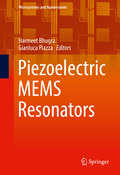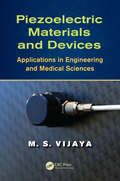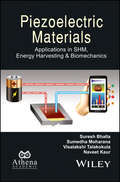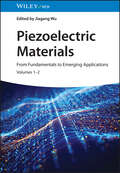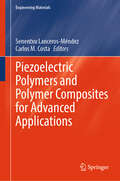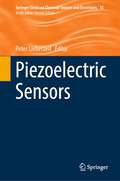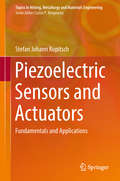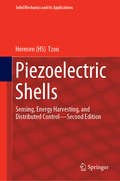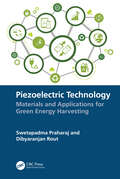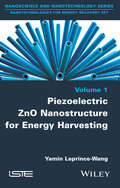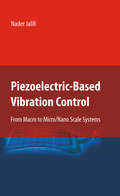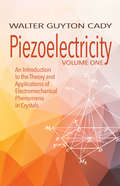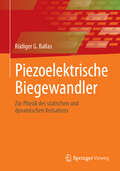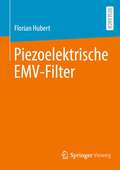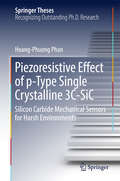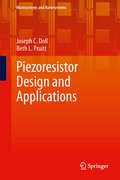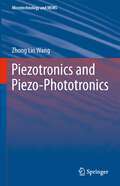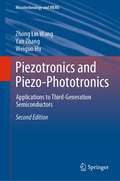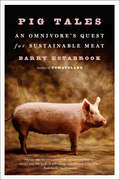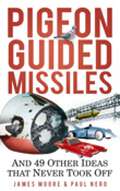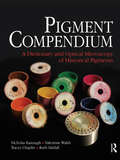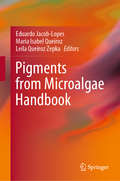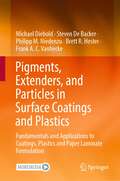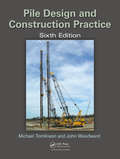- Table View
- List View
Piezoelectric MEMS Resonators
by Harmeet Bhugra Gianluca PiazzaThis book introduces piezoelectric microelectromechanical (pMEMS) resonators to a broad audience by reviewing design techniques including use of finite element modeling, testing and qualification of resonators, and fabrication and large scale manufacturing techniques to help inspire future research and entrepreneurial activities in pMEMS. The authors discuss the most exciting developments in the area of materials and devices for the making of piezoelectric MEMS resonators, and offer direct examples of the technical challenges that need to be overcome in order to commercialize these types of devices. Some of the topics covered include: Widely-used piezoelectric materials, as well as materials in which there is emerging interest Principle of operation and design approaches for the making of flexural, contour-mode, thickness-mode, and shear-mode piezoelectric resonators, and examples of practical implementation of these devices Large scale manufacturing approaches, with a focus on the practical aspects associated with testing and qualification Examples of commercialization paths for piezoelectric MEMS resonators in the timing and the filter markets . . . and more! The authors present industry and academic perspectives, making this book ideal for engineers, graduate students, and researchers.
Piezoelectric Materials and Devices: Applications in Engineering and Medical Sciences
by M. S. VijayaStarting from the fundamentals, this book provides a concise yet complete treatment of piezoelectric materials, an important class of smart materials which are useful as both actuators and sensors. Including case studies, the text introduces different types of dielectric materials, describes the preparation and properties of various piezoelectric materials used in device applications, and presents various engineering and medical applications of piezoelectric materials. It also discusses in detail the design and virtual prototyping of piezoelectric devices using commercially available software tools like ANSYS and PAFEC.
Piezoelectric Materials: Applications in SHM, Energy Harvesting and Biomechanics (ANE/Athena Books)
by Suresh Bhalla Sumedha Moharana Visalakshi Talakokula Naveet KaurPiezoelectric materials are attracting significant research efforts and resources worldwide. The major thrust areas include structural health monitoring, bio-mechanics, bio-medicine and energy harvesting. Engineering and technological applications of this smart material warrants multi-dimensional theoretical and experimental knowledge and expertise in fields of mechanics, instrumentation, digital electronics and information technology, over and above the specific domain knowledge. This book presents, from theory to practice, the application of piezoelectric smart materials in engineering domains such as structural health monitoring (SHM), bio-mechanics, bio-medical engineering and energy harvesting.
Piezoelectric Materials: From Fundamentals to Emerging Applications
by Jiagang WuPiezoelectric Materials Analyze the foundational materials of the electronics industry In recent years piezoelectric materials have become one of the world’s most important classes of functional materials. Their ability to convert between mechanical and electrical energy makes them indispensable for sensors, transducers, actuators, catalysts, and many other foundational electronic devices. As electronics industries expand at unprecedented rates, the range of applications for piezoelectric materials continues to grow. Piezoelectric Materials offers a comprehensive overview of this group of materials, its key properties, and its applications. Beginning with the fundamental science of piezoelectric phenomena, it then analyzes different the numerous different classes of piezoelectric materials and their current and future industrial functions. The result is essential for engineers and materials scientists working in any number of areas. Piezoelectric Materials readers will also find: Analysis of materials types include lead-based and lead-free piezoelectric materials, textured piezoceramics, piezoelectric thin films, and many moreDetailed discussion of applications including dielectric energy storage and biomedical technologyAuthorship by a leading researcher of piezoelectric materials Piezoelectric Materials is ideal for materials scientists, electronic engineers, polymer chemists, solid state chemists, and any other researchers or professionals working with these key materials.
Piezoelectric Polymers and Polymer Composites for Advanced Applications (Engineering Materials)
by Senentxu Lanceros‐Méndez Carlos M. CostaThis book provides a comprehensive exploration of piezoelectric polymers and composites, detailing their structures, fabrication, and applications across fields such as biomedical, electronic, and environmental science. Addressing the demands of Industry 4.0 and the Internet of Things, it delves into the most relevant materials like Polyvinylidene Fluoride and Poly-l-Lactic Acid, highlighting their properties, functionality, and versatility in energy harvesting, sensing, actuation, and biomedical applications, among others. Each chapter introduces fundamental concepts, recent advancements, and future directions, serving as both a reference for current knowledge and a guide for ongoing research in piezoelectric materials science.
Piezoelectric Sensors (Springer Series on Chemical Sensors and Biosensors #18)
by Peter LieberzeitThis book provides a comprehensive overview of piezoelectric sensor devices and instrumentation and their use for chemical and biochemical analysis. Sensors relying on established transducers, such as the quartz crystal microbalance (QCM) and the surface acoustic wave resonator (SAW) are covered, and novel devices like surface transverse wave (STW) resonators, film bulk acoustic resonators (FBAR) as well as non-piezoelectric devices with mass-sensitive properties are presented. As their name implies, such devices respond directly to mass changes on their surfaces and thus address the most fundamental quality of any analytes. First, the book presents the fundamentals of new measuring strategies with these devices. Then, it introduces a variety of chemo- and biosensing application scenarios of these devices. In addition, the book covers both the state-of-the-art of academic research and prospects concerning the commercialization of these sensors. Given its scope, the book is of interest to academics, specialists in industry, and advanced students in the areas of analytical chemistry, rapid analysis, and sensor technology, giving them the unique possibility to familiarize themselves with this chemical sensing strategy. Readers will benefit from the coverage of both cutting-edge research results and applications that help bridge the gap between academia and industry.
Piezoelectric Sensors and Actuators: Fundamentals and Applications (Topics in Mining, Metallurgy and Materials Engineering)
by Stefan Johann RupitschThis book introduces physical effects and fundamentals of piezoelectric sensors and actuators. It gives a comprehensive overview of piezoelectric materials such as quartz crystals and polycrystalline ceramic materials. Different modeling approaches and methods to precisely predict the behavior of piezoelectric devices are described. Furthermore, a simulation-based approach is detailed which enables the reliable characterization of sensor and actuator materials. One focus of the book lies on piezoelectric ultrasonic transducers. An optical approach is presented that allows the quantitative determination of the resulting sound fields. The book also deals with various applications of piezoelectric sensors and actuators. In particular, the studied application areas are · process measurement technology, · ultrasonic imaging, · piezoelectric positioning systems and · piezoelectric motors. The book addresses students, academic as well as industrial reseachers and development engineers who are concerned with piezoelectric sensors and actuators.
Piezoelectric Shells: Sensing, Energy Harvesting, and Distributed Control—Second Edition (Solid Mechanics and Its Applications #247)
by Hornsen Hs TzouThis book offers an introduction to piezoelectric shells and distributed sensing, energy harvesting and control applications. It familiarizes readers with a generic approach of piezoelectric shells and fundamental electromechanics of distributed piezoelectric sensors, energy harvesters and actuators applied to shell structures. The book is divided into two major parts, the first of which focuses on piezoelectric shell continua, while the second examines distributing sensing, energy harvesting and control of elastic continua, e.g., shells and plates.The exploitation of new, advanced multifunctional smart structures and structronic systems has been one of the mainstream research and development activities over the years. In the search for innovative structronics technologies, piezoelectric materials have proved to be very versatile in both sensor and actuator applications. Consequently, the piezoelectric technology has been applied to a broad range of practical applications, from small-scale nano- and micro-sensors/actuators to large-scale airplane and space structures and systems.The book provides practicing engineers and researchers with an introduction to advanced piezoelectric shell theories and distributed sensor/energy harvester/actuator technologies in the context of structural identification, energy harvesting and precision control. The book can also be used as a textbook for graduate students. This second edition contains substantial new materials, especially energy harvesting and experimental components, and has been updated and corrected for a new generation of readers.
Piezoelectric Technology: Materials and Applications for Green Energy Harvesting
by Dibyaranjan Rout Swetapadma PraharajThis book explains the state-of-the-art green piezoelectric energy harvesting (PEH) technology. It highlights different aspects of PEH, starting right from the materials, their synthesis, and characterization techniques to applications. Various types of materials, including ceramics, polymers, composites, and bio-inspired compounds in nano, micro, and meso scale and their recent advancements are captured in detail with special focus on lead-free systems. Different challenges and issues faced while designing a PEH are also included. Features: Guides on how to harvest piezoelectric energy in a sustainable manner. Describes related figures of merit for piezoelectric energy harvesting. Covers synthesis of piezoelectric materials in the form of bulk, single crystal, nano, and thin/thick film. Includes pertinent advanced characterization techniques. Reviews piezo-energy harvesting devices and structures. This book is aimed at researchers, professionals, and graduate students in electrical engineering, materials, and energy.
Piezoelectric ZnO Nanostructure for Energy Harvesting, Volume 1
by Yamin Leprince-WangOver the past decade, ZnO as an important II-VI semiconductor has attracted much attention within the scientific community over the world owing to its numerous unique and prosperous properties. This material, considered as a "future material", especially in nanostructural format, has aroused many interesting research works due to its large range of applications in electronics, photonics, acoustics, energy and sensing. The bio-compatibility, piezoelectricity & low cost fabrication make ZnO nanostructure a very promising material for energy harvesting.
Piezoelectric-Based Vibration Control
by Nader Jalili"Piezoelectric-Based Vibration-control Systems: Applications in Micro/Nano Sensors and Actuators" covers: Fundamental concepts in smart (active) materials including piezoelectric and piezoceramics, magnetostrictive, shape-memory materials, and electro/magneto-rheological fluids; Physical principles and constitutive models of piezoelectric materials; Piezoelectric sensors and actuators; Fundamental concepts in mechanical vibration analysis and control with emphasis on distributed-parameters and vibration-control systems; and Recent advances in piezoelectric-based microelectromechanical and nanoelectromechanical systems design and implementation.
Piezoelectricity: An Introduction to the Theory and Applications of Electromechanical Phenomena in Crystals (Dover Books on Electrical Engineering)
by Walter Guyton CadyAfter World War II, piezoelectric phenomena became extremely important in communications media and were the subject of extensive scientific investigation. This two-volume treatise, written by a major contributor to the field, offers a complete, systematic survey of the physical properties and the practical applications of piezoelectric crystals.
Piezoelectricity: An Introduction to the Theory and Applications of Electromechanical Phenomena in Crystals (Dover Books on Electrical Engineering)
by Walter Guyton CadyAfter World War II, piezoelectric phenomena became extremely important in communications media and were the subject of extensive scientific investigation. This two-volume treatise, written by a major contributor to the field, offers a complete, systematic survey of the physical properties and the practical applications of piezoelectric crystals.
Piezoelektrische Biegewandler: Zur Physik des statischen und dynamischen Verhaltens
by Rüdiger G. BallasDie vielfältigen industriellen Einsatzmöglichkeiten von piezoelektrischen Biegewandlern als Aktoren und hochpräzise Positioniersysteme erfordern eine an die jeweilige Aufgabe angepasste Leistungsfähigkeit. Dies setzt voraus, dass bereits in der Entwurfs- und Entwicklungsphase das statische und dynamische Verhalten solcher Aktor-Strukturen in der jeweiligen Anwendung vorhergesagt werden kann. Die geometrischen Abmessungen der einzelnen aktiven und passiven Schichten, ihre Abfolge im Schichtsystem und ihre elasto- und elektromechanischen Eigenschaften sind dabei Schlüsselfaktoren. Dieses Buch konzentriert sich auf die analytische Beschreibung des statischen und dynamischen Verhaltens von piezoelektrischen Mehrschicht-Biegewandlern. Es soll Studierenden der Natur- und Ingenieurwissenschaften, insbesondere der Physik, der Mikro- und Feinwerktechnik, der Mess- und Sensortechnik, der Mechatronik und Automatisierungstechnik sowie Ingenieur:innen und Wissenschaftler:innen in der Praxis ein solides technisches Werkzeug für den Entwurf von piezokeramischen Biegewandlern an die Hand geben. Die Vorteile der analytischen Beschreibung werden anhand realer Messungen an einem Monomorph in Multilayer-Technologie demonstriert. Die Anforderungen an das Verständnis des Materials beschränken sich auf Grundkenntnisse der ein- und mehrdimensionalen Analysis sowie der elementaren Newtonschen Mechanik, der technischen Mechanik und der Elektrizitätslehre.
Piezoelektrische EMV-Filter
by Florian HubertIm vorliegenden Buch wird eine neue EMV-Filtermaßnahme eingeführt, die auf dem piezoelektrischen Effekt basiert. Piezoelektrische EMV-Filter (PEF) erzeugen bei ihren Resonanzfrequenzen einen niederimpedanten Ausbreitungspfad für leitungsgebundene elektromagnetische Störungen. Dies ermöglicht eine Unterdrückung diskreter Störspitzen. Jenseits der Resonanzen verhalten sich PEF kapazitiv. PEF können daher nicht nur reguläre Funkentstörkondensatoren, wie z.B. Y-Kondensatoren, ersetzen, sondern ermöglichen zusätzlich eine selektive Dämpfung bei dezidierten Störfrequenzen. Es wird gezeigt, dass sich durch Verwendung eines PEF ein kompakterer EMV-Filter realisieren lässt. Hiermit werden Abmessungen, Gewicht und letztendlich die Kosten von EMV-Maßnahmen wesentlich reduziert.
Piezoresistive Effect of p-Type Single Crystalline 3C-SiC
by Hoang-Phuong PhanThis book addresses the piezoresistance in p-type 3C-SiC, which it investigates using experimental characterization and theoretical analysis. The gauge factor, the piezoresistive coefficients in two-terminal and four-terminal resistors, the comparison between single crystalline and nanocrystalline SiC, along with the temperature dependence of the piezoresistive effect in p-type 3C-SiC are also discussed. Silicon carbide (SiC) is an excellent material for electronic devices operating at high temperatures, thanks to its large energy band gap, superior mechanical properties and extreme chemical inertness. Among the numerous polytypes of SiC, the cubic single crystal, which is also well known as 3C-SiC, is the most promising platform for microelectromechanical (MEMS) applications, as it can be epitaxially grown on an Si substrate with diameters of up to several hundred millimeters. This feature makes 3C-SiC compatible with the conventional Si-based micro/nano processing and also cuts down the cost of SiC wafers. The investigation into the piezoresistive effect in 3C-SiC is of significant interest for the development of mechanical transducers such as pressure sensors and strain sensors used for controlling combustion and deep well drilling. Although a number of studies have focused on the piezoresistive effect in n-type 3C-SiC, 4H-SiC and 6H-SiC, comparatively little attention has been paid to piezoresistance in p-type 3C-SiC. In addition, the book investigates the piezoresistive effect of top-down fabricated SiC nanowires, revealing a high degree of sensitivity in nanowires employing an innovative nano strain-amplifier. The large gauge factors of the p-type 3C-SiC at both room temperature and high temperatures found here indicate that this polytype could be suitable for the development of mechanical sensing devices operating in harsh environments with high temperatures.
Piezoresistor Design and Applications
by Joseph C. Doll Beth L. PruittPiezoresistor Design and Applications provides an overview of these MEMS devices and related physics. The text demonstrates how MEMS allows miniaturization and integration of sensing as well as efficient packaging and signal conditioning. This text for engineers working in MEMS design describes the piezoresistive phenomenon and optimization in several applications. Includes detailed discussion of such topics as; coupled models of mechanics, materials and electronic behavior in a variety of common geometric implementations including strain gages, beam bending, and membrane loading. The text concludes with an up-to-date discussion of the need for integrated MEMS design and opportunities to leverage new materials, processes and MEMS technology. Piezoresistor Design and Applications is an ideal book for design engineers, process engineers and researchers.
Piezotronics and Piezo-Phototronics
by Zhong Lin WangThe fundamental principle of piezotronics and piezo-phototronics were introduced by Wang in 2007 and 2010, respectively. Due to the polarization of ions in a crystal that has non-central symmetry in materials, such as the wurtzite structured ZnO, GaN and InN, a piezoelectric potential (piezopotential) is created in the crystal by applying a stress. Owing to the simultaneous possession of piezoelectricity and semiconductor properties, the piezopotential created in the crystal has a strong effect on the carrier transport at the interface/junction. Piezotronics is for devices fabricated using the piezopotential as a "gate" voltage to control charge carrier transport at a contact or junction. The piezo-phototronic effect uses the piezopotential to control the carrier generation, transport, separation and/or recombination for improving the performance of optoelectronic devices, such as photon detector, solar cell and LED. The functionality offered by piezotroics and piezo-phototronics are complimentary to CMOS technology. There is an effective integration of piezotronic and piezo-phototronic devices with silicon based CMOS technology. Unique applications can be found in areas such as human-computer interfacing, sensing and actuating in nanorobotics, smart and personalized electronic signatures, smart MEMS/NEMS, nanorobotics and energy sciences. This book introduces the fundamentals of piezotronics and piezo-phototronics and advanced applications. It gives guidance to researchers, engineers and graduate students.
Piezotronics and Piezo-Phototronics: Applications to Third-Generation Semiconductors (Microtechnology and MEMS)
by Zhong Lin Wang Yan Zhang Weiguo HuCo-authored by the discoverer of the piezotronic effect, this book is a fundamental and comprehensive survey of piezotronics and piezo-phototronics. Piezotronics is a term broadly applied to devices fabricated using the piezopotential as a “gate” voltage to tune/control charge carrier transport at a contact or junction. The piezo-phototronic effect describes the use of the piezopotential to control the carrier generation, transport, separation and/or recombination for improving the performance of optoelectronic devices. The book first introduces the theory of the piezotronic effect and its applications in transistors, sensors, and catalysis. Subsequent chapters comprehensively cover the fundamentals of the piezo-phototronic effect and its impacts on photon sensors, solar cells, and LEDs.The updated and significantly expanded second edition covers the most recent advances and breakthroughs in this field over the last decade — gas, chemical, and biological nanosensors; quantum dots, wells, and wires; piezocatalysis; the piezo-photonic effect; and the pyro-phototronic effect. This seminal book serves as a basic text for scientists and students in the field of piezotronic devices and third-generation semiconductors.
Pig Tales: An Omnivore's Quest for Sustainable Meat
by Barry EstabrookAn eye-opening investigation of the commercial pork industry and an inspiring alternative to the way pigs are raised and consumed in America. Barry Estabrook, author of the New York Times bestseller Tomatoland and a writer of "great skill and compassion" (Eric Schlosser), now explores the dark side of the American pork industry. Drawing on his personal experiences raising pigs as well as his sharp investigative instincts, Estabrook covers the range of the human-porcine experience. He embarks on nocturnal feral pig hunts in Texas. He visits farmers who raise animals in vast confinement barns for Smithfield and Tyson, two of the country's biggest pork producers. And he describes the threat of infectious disease and the possible contamination of our food supply. Through these stories shines Estabrook's abiding love for these remarkable creatures. Pigs are social, self-aware, and playful, not to mention smart enough to master the typical house dog commands of "sit, stay, come" twice as fast as your average pooch. With the cognitive abilities of at least three-year-olds, they can even learn to operate a modified computer. Unfortunately for the pigs, they're also delicious to eat. Estabrook shows how these creatures are all too often subjected to lives of suffering in confinement and squalor, sustained on a drug-laced diet just long enough to reach slaughter weight, then killed on mechanized disassembly lines. But it doesn't have to be this way. Pig Tales presents a lively portrait of those farmers who are taking an alternative approach, like one Danish producer that has a far more eco-friendly and humane system of pork production, and new, small family farms with free-range heritage pigs raised on antibiotic-free diets. It is possible to raise pigs responsibly and respectfully in a way that is good for producers, consumers, and some of the top chefs in America. Provocative, witty, and deeply informed, Pig Tales is bound to spark conversation at dinner tables across America.
Pigeon Guided Missiles: And 49 Other Ideas that Never Took Off
by James Moore Paul NeroDuring the Second World War, an American behavioural psychologist working with pigeons discovered that the birds could be trained to recognise an object and to peck at an image of it; when loaded into the nose-cone of a missile, these pecks could be translated into adjustments to the guidance fins, steering the projectile to its target.Pigeon-Guided Missiles reveals this and other fascinating tales of daring plans from history destined to change the world we live in, yet which ended in failure, or even disaster. Some became the victims of the eccentric figures behind them, others succumbed to financial and political misfortune, and a few were just too far ahead of their time. Discover why the great groundnut scheme cost British taxpayers £49 million, why the bid to build Minerva, a whole new country in the Pacific Ocean, sank, and why the first Channel Tunnel (started in 1881, over a century before the one we know today) hit a dead end.
Pigment Compendium: Optical Microscopy Of Historical Pigments
by Nicholas Eastaugh Valentine Walsh Tracey Chaplin Ruth SiddallThis is an essential purchase for all painting conservators and conservation scientists dealing with paintings and painted objects. It provides the first definitive manual dedicated to optical microscopy of historical pigments. Illustrated throughout with full colour images reproduced to the highest possible quality, this book is based on years of painstaking research into the visual and optical properties of pigments. Now combined with the Pigment Dictionary, the most thorough reference to pigment names and synonyms avaiable, the Pigment Compendium is a major addition to the study and understanding of historic pigments.
Pigments from Microalgae Handbook
by Eduardo Jacob-Lopes Leila Queiroz Zepka Maria Isabel QueirozThe Pigments from Microalgae Handbook presents the current state of knowledge on pigment production using microalgae-based processes, and covers both the scientific fundamentals of this technology and its practical applications. It addresses biology, chemistry, biochemistry, analysis and engineering aspects, as well as applications of natural pigments in photosynthetic organisms. The book also describes the analytical procedures associated with the characterization of pigments and the engineering aspects of microalgal pigment production. It considers the three major classes of pigments(chlorophylls, carotenoids and phycobiliproteins) produced and surveys the main commercial applications of these chemicals.The book offers a valuable source of information for industrial researchers and practitioners in industrial biotechnology, as it covers various engineering aspects of microalgal pigment production, such as bioreactors and bioprocesses, industrial extraction processes, and the bioeconomy of production including life-cycle assessment. The book will also be of interest to undergraduate and graduate students of biochemistry, food chemistry, and industrial microbiology.
Pigments, Extenders, and Particles in Surface Coatings and Plastics: Fundamentals and Applications to Coatings, Plastics and Paper Laminate Formulation
by Michael Diebold Steven De Backer Philipp M. Niedenzu Brett R. Hester Frank A. VanheckeThis book discusses the diverse array of particles that are found in coatings from both a physical and a performance standpoint. It also describes the fundamentals of particle behavior and shows how these affect the performance and properties of their end-use applications. It consists of nineteen chapters, demonstrating the wide range of types of particles found in coatings as well as the diversity of the important attributes they hold. The authors also present a forward looking view of current issues and trends in the coatings industry. In addition, a chapter on the use of particles in paper laminate, a closely aligned field, is included. This book is of interest to formulators of any type of coatings as well as researchers in aligned fields that use high volumes of small particles, such as the plastics and paper industries.
Pile Design and Construction Practice
by John Woodward Michael TomlinsonWritten to Eurocode 7 and the UK National AnnexUpdated to reflect the current usage of Eurocode 7, along with relevant parts of the British Standards, Pile Design and Construction Practice, Sixth Edition maintains the empirical correlations of the original-combining practical know how with scientific knowledge-and emphasizing relevant principles an
